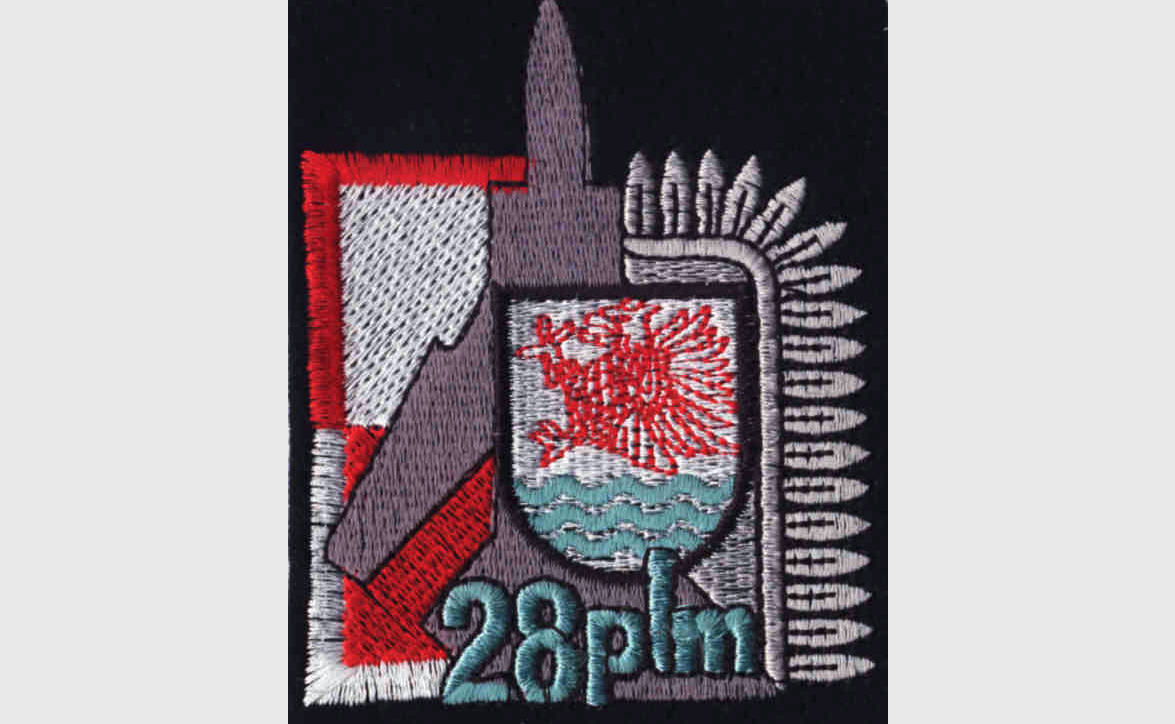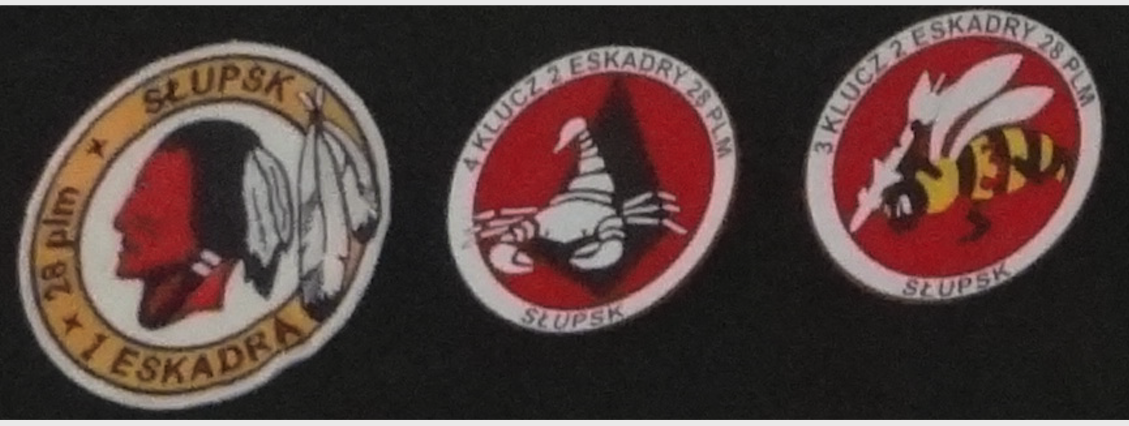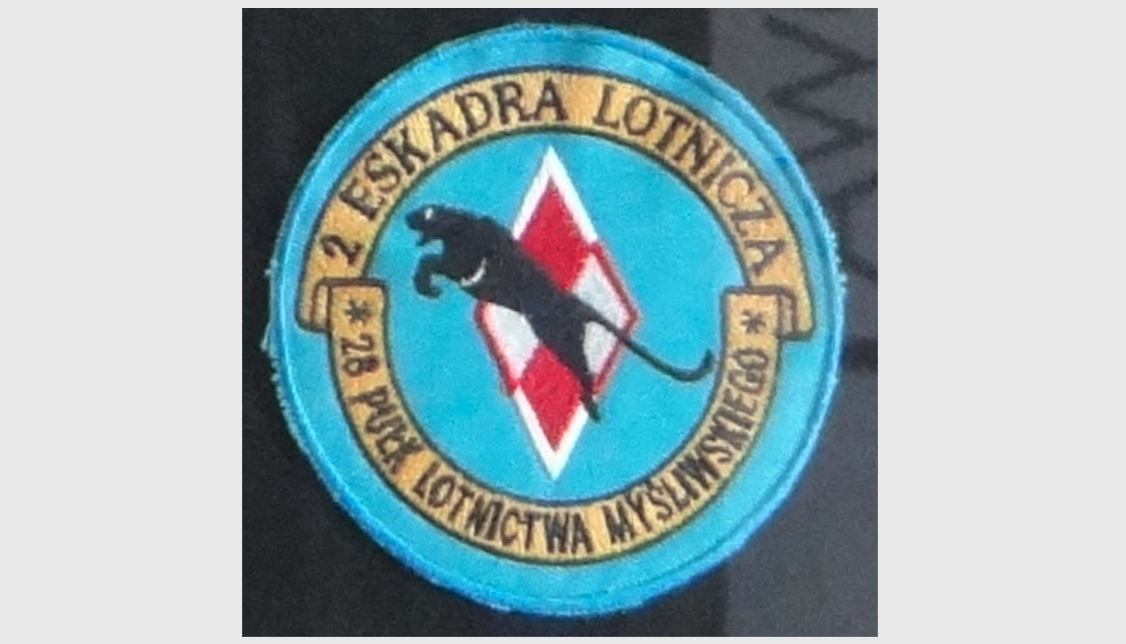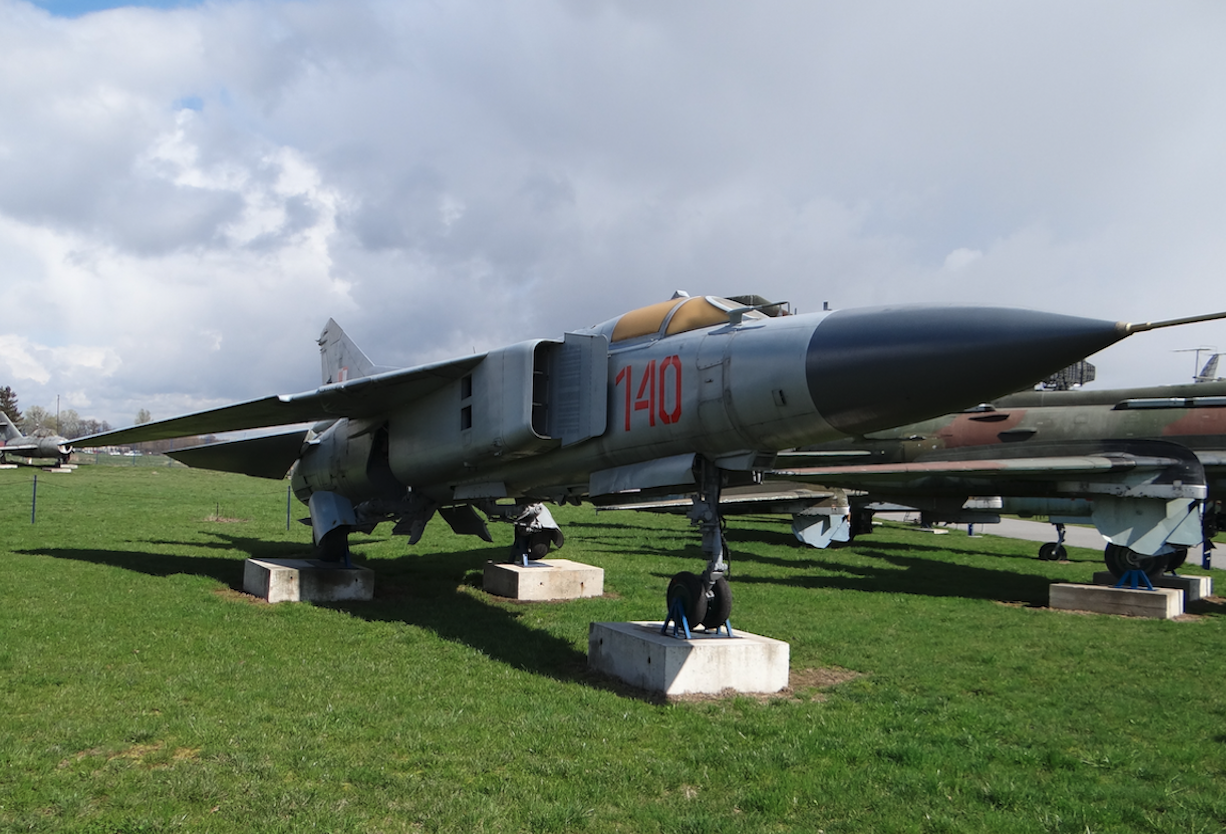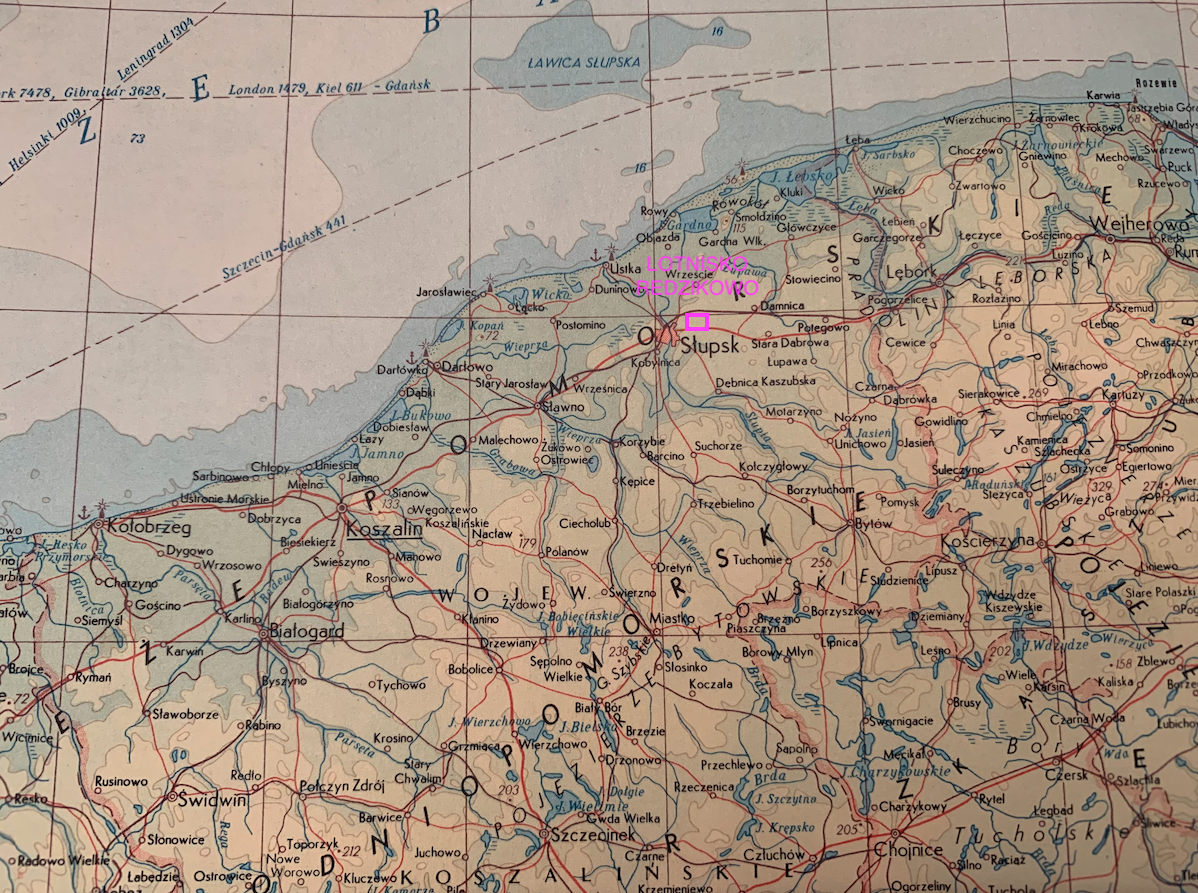Słupsk 2008-01-14
28 Pułk Lotnictwa Myśliwskiego w Słupsku-Redzikowie.
1952r. – 2000r.
Historia 28 PLM.
Powstanie 28. PLM. 17 wrzesień 1952 rok.
28 Pułk Lotnictwa Myśliwskiego został sformowany na podstawie Rozkazu MON Nr 0096 z dnia 11 grudnia 1951 roku, oraz Rozkazu D-cy Wojsk Lotniczych Nr 018 z dnia 21 maja 1952 roku, na bazie istniejącej 10. Dywizji Lotnictwa Myśliwskiego w Redzikowie koło Słupska. Termin osiągnięcia gotowości bojowej wyznaczono na dzień 1 listopad 1952 rok.
W dniach 15-16 wrzesień 1952 roku, grupa 10 samolotów MiG-15 i MiG-15 UTI, została przebazowana z lotniska Bemowo do Redzikowa. Grupą tą dowodził major pilot Wasyl Krymski. Pułk od razu rozpoczął szkolenie na nowoczesnych samolotach myśliwskich MiG-15 i nigdy na stanie nie posiadał myśliwców Jak-23. W dniu 17 września 1952 roku, odbyła się pierwsza zbiórka stanu osobowego 28. PLM, w składzie 62 oficerów i 142 podoficerów i szeregowych. Dzień ten, to był 17 wrzesień 1952 roku, i uznany został za datę powstania 28. PLM w Słupsku, który tak silnie był złączony z miastem, że po latach otrzymał nazwę własną 28. Słupski Pułk Lotnictwa Myśliwskiego.
1953 rok.
28 Pułk jako wiodący w 10. DLM zawsze jako pierwszy otrzymywał nowy sprzęt. Już w 1953 roku, do Pułku wprowadzono pierwsze myśliwce MiG-15 bis. To postępowanie świadczyło o dużej roli 28. PLM, w systemie obrony Polski. Z początkiem 1953 roku, do Pułku zaczęły docierać także pierwsze samoloty myśliwskie Polskiej produkcji Lim-1, będące odpowiednikami sowieckich MiG-15.
Od pierwszych dni istnienia, głównym zadaniem 28. Pułku było szkolenie lotnicze i obrona najważniejszych obiektów administracyjno-gospodarczych, oraz wojsk na Wybrzeżu Środkowym. Wykonaniu tego zadania podporządkowane były zmiany organizacyjno-etatowe Pułku, systematyczna wymiana sprzętu lotniczego i ciągła rozbudowa infrastruktury naziemnej lotniska.
Ucieczki do wolności.
W ciągu bez mała pół wieku demokracji ludowej, czyli od 1944 roku do 1989 roku, zbiegło z polskiej armii do państw zachodnich 52 oficerów, 5 chorążych i 4 podchorążych ze szkoły lotniczej w Dęblinie, u progu oficerskich nominacji. W sumie 61 wojskowych. To są fakty. Nie chcemy być sędziami, ale komentarza nie można uniknąć. W tym temacie wspomnimy o czterech znanych ucieczkach z wykorzystaniem samolotów typu MiG-15 bis, dokonanych przez Franciszka Jareckiego w 1953 roku, Zdzisława Jaźwińskiego w 1953 roku, Zygmunta Gościniaka w 1956 roku i Bogdana Kożuchowskiego w 1957 roku.
Do 1953 roku, ucieczki pilotów samolotami wojskowymi zdarzały się, ale zawsze kończyły się tragicznie. W 1951 roku, po nieudanej próbie uprowadzenia samolotu, został rozstrzelany podoficer z Oficerskiej Szkoły Lotniczej w Dęblinie. W 1952 roku, to samo spotkało instruktora w tejże szkole, podporucznika Edwarda Pytko; gdy uciekał samolotem do RFN, przechwycili go nad terytorium NRD lotnicy sowieccy, zmusili do lądowania i wydali władzom Polskim.
Pierwszemu, któremu udała się ucieczka był Franciszek Jarecki.
W styczniu 1953 roku, podporucznik Franciszek Jarecki dostał przydział do jednostki koło Słupska (28. PLM). To było spełnienie marzeń młodego człowieka. Został pilotem wojskowym. Kontrwywiad Wojskowy, podobnie jak i innych młodych oficerów, starał się namówić Franciszka Jareckiego do współpracy. Stosują jak zwykle groźby i prośby. Chłopak wpadł w panikę, gdyż w dokumentach zataił, że mama jest właścicielka sklepu i ma rodzinę w USA. Dla odwleczenia sytuacji zapisał się do PZPR. Ucieczkę planował sam. Jej celem był Bornholm, na którym, według propagandy, znajdowała się baza NATO. W styczniu 1953 roku, do Polski przyleciały pierwsze egzemplarze najnowocześniejszych myśliwców MiG-15 bis. Rozlokowano je głównie w jednostkach na północy kraju. Między innymi na lotnisku koło Słupska. Zostały one niemal natychmiast włączone w system stałych dyżurów bojowych. Bardzo często pilot przez cały czas pełnienia dyżuru przebywał w kabinie gotowego do startu myśliwca. Radio było bez przerwy na nasłuchu. O tajności samolotu MiG-15 bis świadczy fakt, że ich stojanki były odosobnione, otoczone drutami kolczastymi i pilnowała ich warta. To, że Franciszek Jarecki trafił do tej jednostki świadczy o wysokim poziomie jego wyszkolenia i zaufaniu przełożonych do jego umiejętności. Mógł na przykład trafić do 7. DLM rozmieszczonej na południu kraju i użytkującej w tym czasie myśliwce Jak-23.
W dniu 5 marca 1953 roku, wyznaczono Franciszkowi Jareckiemu pierwszy samodzielny lot na MiG-15 bis nr 3046 / 346. W locie miał być prowadzony przez drugi myśliwiec MiG-15 bis pilotowany przez instruktora porucznika Józefa Caputę. Samoloty wystartowały zgodnie z planem. Skierowały się w kierunku Bałtyku z naborem wysokości do 1 500 m. W trakcie lotu Franciszek Jarecki, jako prowadzony, odłączył się od prowadzącego i ostro zszedł na pułap 200 m. Instruktor zauważył nagłe znikniecie samolotu i zameldował o prawdopodobnym wypadku kolegi. Było to bardzo prawdopodobne. Zdarzały się wypadki utraty przytomności przez młodych pilotów, a i takie zakończone katastrofą. Na poszukiwanie samolotu, a może raczej w pościg za nim, ruszyło 8 sowieckich myśliwców, także MiG-15 bis. Jednak przed startem Franciszek Jarecki zobaczył aktualną częstotliwość alarmową w jednym z dyżurujących na lotnisku myśliwców. Będąc ciągle na nasłuchu, doskonale się orientował w ruchach samolotów nad Bałtykiem. Wykorzystując nieliczna chmury i niski pułap „bawił się w chowanego”. Po 7 minutach lotu doleciał nad Bornholm. Tutaj przekonał się, że nie ma żadnej bazy wojskowej, a tylko zwykłe lotnisko polowe. I tak miał szczęście. Parę miesięcy wcześniej byli tu moskale, którzy oddali wyspę Szwedom-Duńczykom. Franciszek Jarecki idealnie wylądował samolotem.
Franciszka Jareckiego przejęli Brytyjczycy i przekazali go do USA. W Londynie generał Władysław Anders odznaczył go Krzyżem Zasługi z Mieczami. Przyjął go prezydent USA Dwight Eisenhower. Franciszek otrzymał 50 tys. dolarów i obywatelstwo amerykańskie. Obywatelstwo to otrzymał bez konieczności odbycia karencji 7-lat, gdyż „usynowił” go jeden z kongresmanów pochodzenia polskiego. Dziś (2000 rok Franciszek Jarecki jest właścicielem fabryki zaworów precyzyjnych z filiami w Azji i Australii. Był dwa razy żonaty, ma sześcioro dzieci. Żadne z nich nie mówi już po polsku.
Co z samolotem? Franciszek Jarecki nie wiedział, że ustalono nagrodę za sprowadzenie MiG-15 bis na Zachód. To były te owe 50 tysięcy dolarów. Duńczycy maszynę zwrócili po kilku tygodniach ze śladami odlewów gipsowych. W Polsce Franciszka Jareckiego skazano na karę śmierci. Jego przełożonych początkowo kary nie sięgały, gdyż zaledwie dwa miesiące później podobnym „wyczynem” popisał się porucznik Zdzisław Jaźwiński.
1956 rok.
W 1956 roku, podstawowym typem myśliwca były Lim-1, MiG-15, Lim-2, MiG-15 bis. W 1956 roku, do Polski sprowadzono pierwsze myśliwce wyposażone w stacje radiolokacyjne. Było to 12 maszyn MiG-17 PF. Myśliwce te w ilości klucza postanowiono wprowadzić na wyposażenie trzech pułków rozmieszczonych na północy kraju. Jednym z pułków był właśnie 28. PLM w Słupsku. W grudniu 1956 roku, zorganizowano klucz samolotów pościgowych MiG-17 PF.
MiG-19 w 28. PLM. 1958 rok.
W połowie 50-lat wiadomo było, że era samolotów naddźwiękowych nachodzi. Po wielu miesiącach Polskiej dyplomacji udało się uzyskać zgodę na zakup 33 myśliwców naddźwiękowych typu MiG-19 P / PM zdolnych do wykonywania lotów w „każdych warunkach atmosferycznych”. MON postanowiło samoloty te w ilości eskadry uzbroić trzy pułki lotnictwa myśliwskiego. Jednym z nich był 28. PLM.
W 1958 roku, w 28. PLM rozpoczęto przygotowania do wprowadzenia samolotów MiG-19. Wybrano grupę pilotów i techników, którą przeszkolono w CCCP w Nowosiejce koło Krasnodaru. Do 28. PLM pierwsze samoloty MiG-19 P przyleciały z Modlina na początku grudnia 1958 roku. W lipcu 1959 roku, także z Modlina dostarczono 5 samolotów MiG-19 PM. W nowe samoloty przezbrojono jedną eskadrę, a dwie pozostałe latały nadal na samolotach Lim-2, Lim-5. Natomiast 4 samoloty MiG-17 PF w czerwcu 1959 roku, został przekazane do pułków Lotnictwa Operacyjnego.
W dniu 1 stycznia 1962 roku, na stanie 28. PLM było; 5 samolotów MiG-19 PM, 7 samolotów MiG-19 P, 10 samolotów Lim-5, 7 samolotów Lim-2, 3 samoloty SB Lim-1, 4 samoloty MiG-15 UTI, 4 samoloty TS-8 Bies.
W dniu 15.09.1962 roku, 28. Pułk stracił pierwszy samolot MiG-19 PM. Niestety w katastrofie zginął pilot porucznik Jan Drewicz.
W październiku 1964 roku, 28. PLM miał na stanie; 10 samolotów MiG-19 P, 5 samolotów MiG-19 PM, 8 samolotów Lim-5, 11 samolotów Lim-2, 3 samoloty SB Lim-1, 4 samoloty MiG-15 UTI, 4 samoloty TS-8 Bies.
W listopadzie 1965 roku, z 39. PLM w Mierzęcicach przyjęto kolejnych pięć maszyn MiG-19 PM. Natomiast w ciągu 1966 roku, z 39. PLM przyjęto jeszcze kilka MiG-19 P. Było to zgodne z polityką MON, aby najmocniejsze były jednostki na północy Polski, bezpośrednio graniczące z „Zachodem”.
Niestety, w połowie 1966 roku, w awariach utracono dwa MiG-19 PM. Pierwszy samolot rozbił się 20 czerwca 1966 roku, koło miejscowości Lulemino. Pilot major Raszewski uratował się. Drugi samolot utracono równo miesiąc później, 20 lipca 1966 roku, w dosyć niezwykłych okolicznościach. Przeszkalający się na nowy typ samolotu podporucznik pilot Zbigniew Kopacz przez pomyłkę, jeszcze na płycie postojowej lotniska uruchomił dźwignię chowania podwozia. Podwozie obciążone samolotem nie schowało się od razu lecz dopiero podczas rozbiegu. Samolot zaczął szorować dziobem o pas i zapalił się. Pilot zdołał opuścić kabinę lecz samolot MiG-19 PM nb 910 spłonął.
W dniu 16 czerwca 1967 roku, w lądującym bombowcu Ił-28 z 19. Eskadry Holowniczej nastąpiła awaria wyciągarki, co spowodowało, że holowany na zbyt długiej linie „Gacek” zboczył z osi pasa w prawo i doszczętnie rozbił przednią część stojącego na trawie MiG-19 P nb 1012.
W 1970 roku, miała miejsce kolejna katastrofa, a porucznik Władysław Raczkiewicz pilotując MiG-19 P zginął. Pilot nie zdążył wyprowadzić samolotu z lotu nurkowego, podczas ataku na cel naziemny.
W 1970 roku, 28. PLM gościł u siebie eskadrę węgierskich MiG-19 S ( Węgrzy strzelali do celów nawodnych ), natomiast w lipcu 1972 roku, eskadra słupskich MiG-19 przebywała na lotnisku Rybnitz-Damgarten w NRD, gdzie stacjonowały sowiecki 773. PLM wyposażony w samoloty MiG-21 PFM.
W dniu 28 marca 1973 roku, pełniący dyżur w parze dyżurnej kapitan pilot Jan Budek wystartował na MiG-19 P, w celu przechwycenia niezidentyfikowanego samolotu, który znalazł się w Polskiej przestrzeni powietrznej. Po wykonaniu zadania nie wrócił na macierzyste lotnisko. Najprawdopodobniej samolot wpadł do Bałtyku. Okoliczności wypadku nie wyjaśniono.
W dniu 4 grudnia 1974 roku, odbyły się ostatnie, nocne loty MiG-19. Rozstanie się z nimi nie było bez problemów. W lądującym samolocie majora Bonifacego Treli nie wyszło przednie podwozie.
W maju 1975 roku, z wycofanych MiG-19 P, PM wymontowano silniki, które zostały sprzedane do CCCP z przeznaczeniem na napęd latających celów Ła-17. Natomiast w czerwcu 1975 roku, rozmontowane kadłuby transportem kołowym zostały przewiezione na poligon w Nadarzycach, gdzie po ponownym złożeniu służyły jako cele naziemne.
Cztery samoloty zostały zachowane, jeden pozostał w pułku MiG-19 PM nb 908, a dwa trafiły do muzeów w Kołobrzegu MiG-19 P nb 728 i Krakowie MiG-19 PM nb 905. Czwarty samolot został ustawiony na cokole koło dworca PKP w Świdwinie, lecz po pewnym czasie, podczas bardzo silnej wichury, spadł i został złomowany.
Samoloty MiG-19 kilkakrotnie demonstrowano na pokazach lotniczych. Był to zazwyczaj przelot grupy samolotów oraz pilotaż indywidualny połączony z przekroczeniem, na dużej wysokości, prędkości dźwięku.
Samoloty MiG-19 P / PM w Polsce.
Lp. Wersja, numer burtowy, nr seryjny, Miejsce stacjonowania, Uwagi
Pierwsza dostawa MiG-19 P.1-1 720 Modlin Modlin jako CSL ( Centrum Szkolenia Lotniczego ) był bazą do przeszkalania pilotów na myśliwce MiG-19.
2-2 724 Modlin
3-3 725 ? Modlin Z powodu awarii układu sterowania w locie samolot uległ deformacji. Pilot przeżył -Roman Operacz
4-4 726 Modlin
5-5 727 Mierzęcice Katastrofa podczas startu z powodu asymetrii ciągu 2.08.1966r .Pilot zginął – Eugeniusz Nasiorowski
6-6 728 Muzeum Oręża Polskiego w Kołobrzegu. Po pewnym czasie otrzymał niewłaściwy nb 723
7-7 729 ? Słupsk-Rędzikowo Pilot nie wyprowadził maszyny po ataku z lotu nurkowego . Pilot zginął – Władysław Raczkiewicz
8-8 730
9-9 739 W dniu 30.06.1960r.Major pilot Tadeusz Góra. Podczas lotu przerywa pracę jeden silnik, a po chwili drugi. Pilot ląduje przymusowo, odnosząc obrażenia.
Druga dostawa MiG-19 P
10-1 1008
11-2 1009 ? Słupsk-Rędzikowo Zaginął nad Bałtykiem po wykonaniu lotu bojowego 28.03.1973r Pilot zginął – Jan Budek
12-3 1010 ?
13-4 1011
14-5 1012 Uszkodzony na ziemi 16.06.1967r Bez pilota
15-6 1020 ?
16-7 1021
17-8 1022 ?
18-9 1023 ?
19-10 1024
Trzecia dostawa MiG-19 PM
20-1 904
21-2 905 Muzeum Lotnictwa w Krakowie
22-3 906 ? Słupsk-Rędzikowo Utracony w katastrofie 15.09.1962r . Pilot zginął – Jan Drewicz
23-4 907 ? Słupsk-Redzikowo Rozbity koło miejscowości Lulemino 20.06.1966r. Pilot przeżył – Raszewski
24-5 908 / 65-0908 Słupsk-Redzikowo Pozostał w Słupsku jako eksponat. Po pewnym czasie otrzymał nb 1958 co odzwierciedla datę jego wprowadzenia.
25-6 909 ?
26-7 910 Słupsk-Rędzikowo Zniszczony podczas startu 20.07.1966r. Pilot przeżył – Zbigniew Kopacz
27-8 911 ?
28-9 912 ?
29-10 913 ?
30-11 914 ?
31-12 915
32-13 916
33-14 917
Inne wydarzenia w 28. Pułku.
W dniu 11 października 1959 roku, z rąk generała brygady M. Jakubika, jednostka 28. PLM otrzymał sztandar nadany przez Radę Państwa, w uznaniu za osiągnięcia w szkoleniu i opanowanie techniki wojskowej. W 1962 roku, w wyniku zmian organizacyjnych, 28. PLM wszedł w skład wyodrębnionego nowego rodzaju Sił Zbrojnych – Wojsk Obrony Powietrznej Kraju. Zmiany te były zapoczątkowane już z końcem 50-lat. Wówczas to zlikwidowano dywizje wojsk OPL OK. W ich miejscu powstały, podobnie jak w Lotnictwie Operacyjnym – Korpusy. 28. PLM w Słupsku wszedł w skład 2. Korpusu Wojsk Obrony Powietrznej Kraju.
W 1962 roku, w skład 2. Korpusu z dowództwem w Bydgoszczy wchodziły pułki; 11. PLM w Debrznie, 25. PLM w Pruszczu Gdańskim, 26. PLM w Zegrzu Pomorskim, 28. PLM w Słupsku, 34. PLM w Babich Dołach, który poprzednio był w Marynarce Wojennej, 19. Eskadra Holownicza w Słupsku, 43. Eskadra Lotnictwa Łącznikowego w Bydgoszczy. Dodatkowo pod 2. Korpus podlegały; 129. Pułk Artylerii OPL w Szczecinie, 136. Pułk Artylerii OPL w Bydgoszczy, Bataliony Radiotechniczne; 2. w Grudziądzu, 8. w Słupsku, 9. w Choszcznie.
MiG-21 w 28. PLM. 1973 roku.
W 1973 roku, wprowadzono do eksploatacji samoloty MiG-21 MF, wyposażając I i II eskadrę. Samoloty były fabrycznie nowe. Pułk przyjął ich na stan w okresie 1973r. – 1974r, 22-24 egzemplarze. Przyjęto na wyposażenie także 2 nowe egzemplarze szkolno-bojowych MiG-21 UM. Dzięki tym nowym maszynom Pułk mógł całkowicie spisać ze stanu myśliwce MiG-19. Jednak okres eksploatacji tych maszyn w Pułku był bardzo krótki, gdyż w 1979 roku, przyjęto do służby nowy typ myśliwca MiG-23.
MiG-23 w 28. PLM. 1979 rok.
Rok 1979 był przełomowym w historii jednostki. Grupa 13 pilotów, oraz 28 osób personelu technicznego odbyła szkolenie w Ługawoje w CCCP na samoloty MiG-23 MF/UB. W szkoleniu tym uczestniczyli następujący piloci: ppłk. pil. Janusz Dorożyński, ppłk. pil. Waldemar Piegza, mjr pil. Bogdan Sokołowski, mjr pil. Mieczysław Walentynowicz, kpt. pil. Andrzej Jasiński, kpt. pil. Tadeusz Potaczała, kpt. pil. Zbigniew Różalski, kpt. pil. Stanisław Szafruga, por. pil. Jerzy Bekus, por. pil. Ryszard Drzymała, por. pil. Marian Krzemiński, por. pil. Janusz Rybicki, por. pil. Czesław Zabiełło (nie ukończył szkolenia).
W tym czasie, lotnisko w Redzikowie przechodziło kapitalny remont mający na celu przygotowanie głównego pasa startowego (RWY), oraz dróg kołowania pod przyjęcie nowych samolotów. Już w dniu 4 czerwca 1979 roku, na lotnisku w Mińsku Mazowieckim wylądowało pierwszych 11 samolotów MiG-23 MF/UB, natomiast w dniu 11 czerwca 1979 roku, odbyły się pierwsze loty szkoleniowe. Jako pierwsi, na samolocie MiG-23 UB nr boczny 845 lot wykonali: ppłk. pil. J. Dorożyński, oraz mjr pil. B. Sokołowski. W dniu 4-7 stycznia 1980 roku, 14 samolotów MiG-23 UB/MF przebazowało się do Redzikowa, inaugurując szkolenie pilotów z macierzystego lotniska.
Wykaz samolotów myśliwskich MiG-23 MF służących w 28. SPLM.
Lp. Numer taktyczny, Numer seryjny, Rok wycofania ze służb.
1 120 0390217120 1996
2 121 0390217121 1996
3 122 0390217122 1996
4 139 0390217139 1996
5 140 0390217140 1981
6 141 0390217141 Rozbity 30.08.1988
7 145 0390217145 Rozbity 05.05.1984
8 146 0390217146 1996
9 147 0390217147 1997
18 145 0390217148 1996
11 149 0390217149 1997
12 150 0390217150 Rozbity 14.07.1988
13 455 0390220455 1998
14 456 0390220456 1998
15 457 0390220457 1994
16 458 0390220457 1998
17 459 0390220459 1998
18 460 0390220460 1997
19 461 0390220461 1998
20 001 0390221001 1998
21 005 0390221005 1998
22 007 0390221007 1998
23 010 0390221010 1997
24 012 0390221012 1998
25 062 0390224062 1999
26 065 0390224065 1999
27 101 0390224101 1999
28 102 0390224102 1999
29 105 0390224105 Rozbity 13.11.1985
30 110 0390224110 1999
31 115 0390224115 1999
32 117 0390224117 1999
33 021 0390224021 1993
34 050 0390224050 1999
35 152 0390224152 1993
36 153 0390224153 1993
Wykaz samolotów szkolno-bojowych MiG-23 UM służących w 28 SPLM.
Lp. Numer taktyczny, Numer seryjny, Rok wycofania ze służb.
1 845 A1037845 1999
2 846 A1037846 1999
3 850 A1038850 1996
4 842 A1038842 1998
5 844 A1038844 1998
6 831 A1038831 1999
Od 1 lipca 1991 roku, Pułk wykonywał zadania w ramach Wojsk Lotniczych i Obrony Powietrznej. W dniu 1 września 1995 roku, Decyzją Ministra Obrony Narodowej nr 94/MON z dnia 11 lipca 1995 roku, Pułk przyjął nazwę wyróżniającą "Słupski", i odtąd jego pełna nazwa brzmiała: 28. "Słupski" Pułk Lotnictwa Myśliwskiego. Od tego samego roku, rocznica pierwszej zbiórki Pułku – dzień 17 wrzesień – została Decyzją MON nr 94 uznana jako "Święto Pułku". W końcu roku, dnia 9 grudnia Pułk otrzymał nowy sztandar ufundowany przez społeczeństwo miasta Słupska i Ziemi Słupskiej. Przewodniczącym Społecznego Komitetu Fundatorów był Prezydent Słupska, Pan J. Mazurek. W imieniu Prezydenta RP, sztandar Dowódcy 28 PLM, ppłk. pil. R. Bruździakowi, wręczył gen. dyw. pil. Henryk Pietrzak – Szef Sztabu WLiOP.
Od początku istnienia Pułku, pełniony był dyżur bojowy, minimum parą samolotów, z kilkuminutowym czasem gotowości do startu. Wielokrotnie, szczególnie w 50-latach i 60-latach samoloty dyżuru bojowego startowały i przechwytywały obce statki powietrzne, weryfikowały dane o okrętach rozpoznawczych działających na Bałtyku, przeciwdziałały innym obiektom latającym – na przykład balonom. Dyżurne siły i środki stanowisk dowodzenia, oraz samoloty udzielały również pomocy innym statkom powietrznym.
W miarę doskonalenia struktur organizacyjnych, wprowadzania nowego sprzętu i uzbrojenia zmieniała się treść zadań szkoleniowych Pułku, systematycznie weryfikowana w ćwiczeniach, w trakcie których niejednokrotnie działania prowadzono jednocześnie z dwóch lotnisk i drogowego odcinka lotniskowego (DOL). Wielokrotnie Pułk brał udział w ćwiczeniach organizowanych na szczeblu Wojska Polskiego, a do 1988 roku, w ćwiczeniach Układu Warszawskiego, współdziałając z lotnictwem CCCP i NRD.
Po wprowadzeniu na uzbrojenie samolotów MiG-23 MF/UB, Pułk w latach 1980, 1982, 1984, 1985 brał udział w ćwiczeniach na terytorium CCCP połączonych ze strzelaniem do celów powietrznych. Postawione zadania za każdym razem wykonano na ocenę bardzo dobrą. Mistrzowskie opanowanie techniki lotniczej piloci Pułku prezentowali społeczeństwu po raz pierwszy w defiladzie lotniczej 8.09.1957 roku, w Warszawie. Ponadto Pułk brał udział m.in. w defiladach w 1959 roku, gdzie zaprezentowano ugrupowanie 3 rombów po 16 samolotów; 1960 roku, – w 550 rocznicę bitwy pod Grunwaldem piloci brali udział w locie tzw. "tafli"; 1966 roku, – Udział w defiladzie 1000-lecia Państwa Polskiego; 1969 roku, – w defiladzie XXV-lecia PRL.
Za całokształt wyszkolenia i wzorową realizację zadań, Pułk był wielokrotnie wyróżniany przez przełożonych. Najważniejszym wyróżnieniem było nadanie w latach 1975, 1981, 1985 medalu "Za osiągnięcia w służbie wojskowej".
W latach 90-tych podstawowe zadania Pułku nie uległy zasadniczym zmianom. Priorytetem pozostało bezpieczne szkolenie lotnicze, którego wynik weryfikowały odbyte ćwiczenia, w tym corocznie od 1992 roku, strzelania rakietowe na poligonie w Ustce, oraz ćwiczenia połączone z lądowaniem na drogowym odcinku lotniskowym ( DOL ).
Kunszt pilotażu piloci pułku na samolotach MiG-23 MF prezentowali w licznych pokazach lotniczych, m.in. Air Show’91 w Poznaniu, w 1993 roku, w Gdyni i Dęblinie ( symulowana walka powietrzna 4 MiG-23MF z 4 MiG-29 z 1 PLM ), a w 1996 roku, w Bydgoszczy. Wszystkie zadania w powietrzu, w latach 90-tych, piloci wykonywali bezpiecznie. Dowódca WLiOP za lata 1992, 1993, 1995, 1996 wyróżnił Pułk dyplomem i Pucharem Przechodnim za Bezpieczeństwo Lotów. W 1997 roku, Pułk otrzymał na własność Puchar Dowódcy WLiOP za Bezpieczeństwo Lotów. W 1992 roku, Pułk był trzykrotnie poddany kontroli inspektorów KBWE z Francji, Norwegii, Belgii. W latach 1992-96, Pułk odwiedziło wiele delegacji zagranicznych w tym m.in.: piloci USAF – uczestnicy operacji Pustynna Burza (1992), Dowódca 3 Armii USAF i 48 TFW z Lakenheath (1993), szef Sztabu Sił Powietrznych Francji (1994), przedstawiciele 4 Dywizji Lotniczej z Niemiec (1995), Dowódca Sił Powietrznych Królestwa Szwecji (1996). Szczególna była wizyta pilotów i obsługi naziemnej 493FS/48TFW USAF na 2 samolotach F-15 C/D we wrześniu 1994 roku. Goście, wraz z Dowódcą WLiOP gen. Dyw. J. Gotowałą wzięli udział w obchodach 42 rocznicy powstania Pułku. Odbyły się również wspólne loty samolotów MiG-23 MF/UB i F-15 C/D. W dniu 25.11.1996 roku, Pułk gościł gen. Michaela E. Ryana – dowódca USAF Europie, wraz z dowódcą 52 TFW USAF w Spangdahlem. Celem wizyty było nawiązanie współpracy pomiędzy 52 TFW i 28 PLM.
Po raz pierwszy w historii w dniach 2-13.10.1995 roku, grupa 4 samolotów MiG-23 MF/UB wraz z pilotami i obsługą naziemną wzięła udział w ćwiczeniach p.k. Cooperative Jaguar’95 operując z bazy NATO Karup w Danii. We wrześniu 1996 roku, odbyły się ćwiczenia p.k. Amber Express, w których m.in. piloci brali udział we wspólnych lotach z maszynami SP RFN. Przedsięwzięcie było realizowane w ramach programu "Partnerstwo dla Pokoju". W 1997 roku, piloci i obsługa naziemna uczestniczyli w polsko-amerykańskim ćwiczeniu "Orli Szpon", tocząc m.in. symulowane walki powietrzne z maszynami USAF.
W związku z kończeniem resursów przez kolejne egzemplarze samolotów MiG-23, oraz z polityką oszczędnościową MON, postanowiono wycofać z uzbrojenia maszyny tego typu. Ostatnie loty szkolne odbyły się w dniu 2.09.1999 roku. Wzięło w nich udział 5 samolotów MiG-23 MF i 2 MiG-23 UB. Natomiast ostatni lot MiG-23 UB w barwach WLiOP odbył się w dniu 30.11.1999 roku. Część samolotów skreślonych z inwentarza WLiOP i przekazano do AMW (Agencja Mienia Wojskowego) w celu sprzedaż kolekcjonerom, natomiast kilka najmłodszych egzemplarzy (samoloty 24 serii), mających jeszcze spory zapas resursu przetransportowano na poligon lotniczy w Nadarzycach i tam "rozstrzelano".
Lotnisko Słupsk Redzikowo.
Lotnisko położone jest na wschód od centrum Słupska, w odległości około 3 km., w obszarze wsi Redzikowo, której poprawna nazwa to także Rędzikowo. Obie nazwy są poprawne. Lotnisko leży w pobliżu drogi krajowej Nr 6 pomiędzy Słupskiem a Lęborkiem. Z lotniska jest odległe około 20 km od Morza Bałtyckiego. Lotnisko wyposażone jest w pas startowy (RWY) o wymiarach 2 200 m x 60 m, o nawierzchni betonowej, o orientacji 09/27. Lotnisko ma współrzędne geograficzne 54,28 N 17,06 E i leży na wysokości 66 m npm. Obecnie ( 2008 rok ) pełni wyłącznie rolę lotniska sanitarnego. Czasami odbywają się na nim festyny kulturalne. Są plany na umieszczenie na nim elementów „Tarczy Rakietowej” USA.
Rozformowanie Pułku. 31.12.2000 rok.
W wyniku powyższych działań, Ministerstwo Obrony Narodowej decyzją nr MON PF24/ORG z dnia 3.10.2000 roku, podjęło decyzję o rozformowaniu jednostki. 28 "Słupski" Pułk Lotnictwa Myśliwskiego zakończył działalność, oraz przeszedł do historii z dniem 31.12.2000 roku. Przede wszystkim musimy pamiętać o 19 Polskich pilotach, którzy ponieśli śmierć pełniąc służbę na straży Polski w 28 SPLM.
Dowódcy 28 PLM.
WYKAZ DOWÓDCÓW 28 "Słupskiego" Pułku Lotnictwa Myśliwskiego.
- mjr pil. Wasyl Krymski – 15.09.52 – 20.01.53
- mjr pil. Wiktor Iwoń – 21.01.52 – 16.08.53
- kpt. pil. Rafał Bulak – 17.08.53 – 10.02.54
- mjr pil. Czesław Dużyński – 11.02.54 – 09.07.54
- mjr pil. Roman Czajkowski – 11.07.54 – 06.11.55
- kpt. pil. Józef Caputa – 07.11.55 – 08.06.56
- ppłk. pil. Jan Kamela – 09.06.56 – 10.09.61
- mjr pil. Jerzy Figurski – 11.09.61 – 18.09.64
- ppłk. pil. Henryk Dańko – 19.09.64 – 19.02.68
- mjr pil. Marcin Kawczyński – 20.02.68 – 18.08.69
- ppłk pil. Władysław Jędrych – 19.08.69 – 30.03.72
- ppłk. pil. Henryk Pietrzak – 31.03.72 – 19.03.77
- ppłk pil. Janusz Dorożyński – 20.03.77 – 17.02.83
- ppłk. pil. Bogdan Sokołowski – 18.02.83 – 26.09.86
- ppłk. pil. Franciszek Klimczuk – 27.09.86 – 09.04.91
- mjr pil. Ryszard Bruździak – 10.04.91 – 16.05.96
- ppłk. pil. Ireneusz Bijata – 17.05.96 – 28.02.98
- ppłk. pil. Bogdan Wójcik – 29.02.98 – 31.12.00
UWAGA: Stopnie wojskowe dowódców z dnia objęcia obowiązków służbowych.
Samoloty używane w 28 PLM w Słupsku;
Mikojan i Guriewicz MiG-15,
Mikojan i Guriewicz MiG-15 UTI ( UTI MiG-15 ),
WSK Lim-2,
WSK SB Lim-1,
WSK Lim-5,
Mikojan i Guriewicz MiG-17 PF,
Mikojan i Guriewicz MiG-19 P,
Mikojan i Guriewicz MiG-19 PM,
WSK TS-8 Bies,
WSK TS-11 Iskra,
Mikojan i Guriewicz MiG-21 MF,
Mikojan i Guriewicz MiG-21 UM,
Mikojan i Guriewicz MiG-23 MF,
Mikojan i Guriewicz MiG-23 UM.
Opracował Karol Placha Hetman

